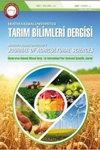荧光假单胞菌对棉花幼苗病害的生物防治。
IF 1.1
4区 农林科学
Tarim Bilimleri Dergisi-journal of Agricultural Sciences
Pub Date : 2016-08-25
DOI:10.1501/TARIMBIL_0000001398
引用次数: 3
摘要
包括棉花在内的许多植物的幼苗根腐病是造成重大经济损失的重要病害。由于使用杀菌剂控制疾病,人类健康和环境受到负面影响。本研究的目的是确定荧光假单胞菌(FP)细菌在体外和体内条件下对幼苗根腐病病原体的作用。采用体外双培养法对棉花和杂草根际分离的59株FP进行了鉴定。将有效的FP分离物施用于种子后,在气候室中研究了对幼苗根腐病病原体的拮抗作用。双培养试验结果表明,FP40对茄枯丝核菌的抑制效果最高,为49.60%。其中,FP51、FP48和FP35对镰刀菌的影响最大,分别为43.80%、43.50%和43.10%。对deliense的影响最大的是FP57(59.80%)、FP52(57.80%)和FP56(57.60%)。虽然分离物FP35和FP57对气候室中所有三种病原体的保护作用超过70%,但它们与商业杀菌剂(Vitavax和Maxim)和生物杀菌剂(Subtilex)一样有效,并显示出令人满意的结果。本文章由计算机程序翻译,如有差异,请以英文原文为准。
Biological Control of Cotton Seedling Diseases by Fluorescent Pseudomonas spp.
Seedling root rot seen in many plants including cotton is an important disease that leads to large economic losses. Human health and the environment are negatively affected as a result of using fungicides for disease control. The goal of this study was to determine the effects of fluorescent Pseudomonas (FP) bacteria against seedling root rot pathogens both in vitro and in vivo conditions. 59 FP isolates obtained from the rhizosphere of cotton and weeds on the field were tested by dual-culture assays in vitro. After applying effective FP isolates on the seeds, antagonistic effects against the seedling root rot pathogens were investigated in a climate chamber. Resulting of dual-culture tests, FP40 had maximum effect (49.60%) against Rhizoctonia solani. Besides, FP51, FP48 and FP35 had highest impact as 43.80%, 43.50%, and 43.10% against Fusarium sp., respectively. Pythium deliense was mostly effected by FP57 (59.80%), FP52 (57.80%) and FP56 (57.60%). While isolates FP35 and FP57 provided protection over 70% against all three pathogens in a climate chamber, they were as effective as commercial fungicides (Vitavax and Maxim) and biofungicide (Subtilex) and shown promising results.
求助全文
通过发布文献求助,成功后即可免费获取论文全文。
去求助
来源期刊
CiteScore
1.40
自引率
0.00%
发文量
26
期刊介绍:
Journal of Agricultural Sciences (JAS) is an international, double-blind peer-reviewed, open-access journal, published by the Faculty of Agriculture, Ankara University. The journal invites original research papers containing new insight into any aspect of Agricultural Sciences that are not published or not being considered for publication elsewhere. Preliminary, confirmatory or inconclusive research, review articles, case and local studies and works presenting taxonomy will not be published.

 求助内容:
求助内容: 应助结果提醒方式:
应助结果提醒方式:


